Cedar-Waxwing-with-redcedar-seed-cone. ©GaryBrady
Cedar Waxwings: Winter Texans Snack on Bugs and Berries
Dr. James J. S. Johnson
But he himself [i.e., Elijah] went a day’s journey into the wilderness, and came and sat down under a juniper tree; and he requested for himself that he might die; and said, It is enough; now, O Lord, take away my life, for I am not better than my fathers. And as he lay and slept under a juniper tree, behold, then an angel touched him, and said unto him, Arise and eat. And he looked, and, behold, there was a cake baked on the coals, and a cruse of water at his head. And he did eat and drink, and laid himself down again. (1st Kings 19:4-6)
The above Scripture reports how the persecuted prophet Elijah, a fugitive fleeing Queen Jezebel, was miraculously fed a hot meal, by an angel, under a juniper tree. But the bird featured herein — CEDAR WAXWING (see feature photo by Gary Brady, above) — would need no miracle or angel to find food at a juniper tree, because the Cedar Waxwing’s diet is famous for including “juniper berries”, a nickname given to the evergreen redcedar tree’s seed cones (that are signified by the Cedar Waxwing’s name).
Cedar Waxwing with redcedar seed cone (a/k/a “juniper berry”)
Fair Use credit: Missouri Dep’t of Conservation photo
Cedar Waxwings are insectivorous – they often resemble flycatchers as they pursue and capture their aerial insect prey; in fact, insects are their main diet when berries are unavailable. However, Cedar Waxwings thrive on seeds, including redcedar cones (nicknamed “juniper berries”), which are berry-like female seed cones. (Each seed cone, technically called a megastrobilus, is bluish-purple within a waxy-whitish envelope, appearing somewhat like blueberries if seen in its wax coating.) Cedar Waxwings also enjoy eating available fruits (e.g., apples) and a variety of perennial plant berries, especially during winter, when insects are mostly unavailable. [See, accord, Thomas Alerstam, BIRD MIGRATION (Cambridge University Press, 1993), pages 167, 182, 195, 203.] 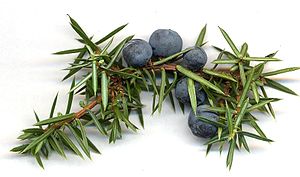
Juniper “berries” with evergreen needle-leaves (Wikipedia photo)
Cedar Waxwings are very social passerines – they are even known to share berries, passing them from one bird to another (form beak to beak) in a line, so that each waxwing gets its share of the berries. [See Robert Rice, “The Moveable Feaster: Cedar Waxwing”, Smithsonian’s National Zoo & Conservation Biology Institute (May 1st 1997), posted at https://nationalzoo.si.edu/migratory-birds/news/moveable-feaster .] As gregarious birds, Cedar Waxwings travel—and stopover—in compact flocks. This “caravan”-style migration is noted in the following birdwatching limerick of mine (which commemorates my observations of them, perching as a group, on April 1st (of AD2017):
CEDAR WAXWINGS, PASSING THROUGH, STOP OVER IN DOUBLE OAK
Humankind, earthbound, lacks wings;
Unlike us, though, Cedar Waxwings,
Like migratory troops,
Stopping over in groups –
Passing through, Cedar Waxwings.
[See also, comment on seeing waxwing stopover, https://leesbird.com/2016/04/04/lees-one-word-monday-4416/#comment-762787 — posted 4-1-AD2017.]
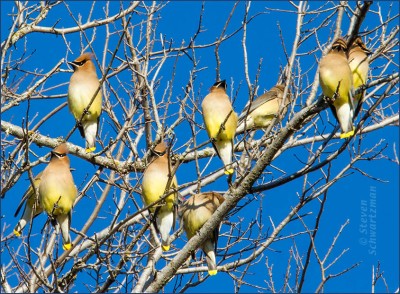
Flock of perching “winter Texan” Cedar Waxwings (Steven Schwartzman photo)
Cedar Waxwings (Bombycilla cedrorum) are well-known crested migrants of North America (and to the Caribbean, and even as far south as Panama), yet their larger “cousins” — Bohemian Waxwings (Bombycilla garrula) — live and migrate within both North America and Europe. [See Thomas Alerstam, BIRD MIGRATION (Cambridge University Press, 1993), pages 164, 316, 337.]
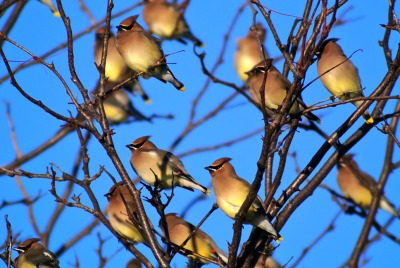
Cedar Waxwings perching in Wisconsin (Mike McDowell photo)
Cedar Waxwings themselves are widespread migrants, migrating phenologically with seasonal weather cycles. Roger Tory Peterson summarizes the Cedar Waxwing’s broad migratory range (in North America and the Caribbean) as follows:
Where found: Se. Alaska, cent. Canada south to n. California, w. Oklahoma, and Georgia. Winters from s. Canada to Panama, West Indies. Texas: Winters (Oct.-June) throughout. Habitat: Various; semi-open, wooded, towns, etc.
[Quoting Roger Tory Peterson, BIRDS OF TEXAS: A FIELD GUIDE TO THE BIRDS OF TEXAS AND ADJACENT STATES (Houghton Mifflin / Peterson Field Guides, 1988), page 191.] Yet think about the marvels of migration – it’s easier to pronounce the word than it is to successfully accomplish the aerial journey! For starters, what kind of weather is right for migration?
Which factors govern the migrants’ choice of migration weather?
Three such factors can be considered to be of great importance: the living conditions in the area the birds are leaving, the living conditions in the area for which they are heading, and the flying conditions during the migration itself.
If the birds’ choice of migration weather were mainly an adaptation [i.e., providentially prepared-for response] to the conditions in the area they are leaving, then in the first place cold, frost, snow and formation of ice, [i.e.] weather factors which make their living conditions considerably worse, ought to trigger emigration. Similar weather in the destination area, if it could be foreseen by the birds, naturally ought to have the effect of deterring migration [i.e., immigration to the new location].
Where the flying conditions during the migration are concerned, two factors are of the greatest importance to the birds: they should carry out the flight as economically as possible from an energy [consumption] point of view[,] and they should avoid weather which may lead to [navigational] orientation problems. The first factor is provided for if the birds choose tail winds, and the second if they avoid flying in rain, fog and dense cloud[s]. That precisely those points, tail winds and avoiding of areas of rain, usually are key factors for intensive migration has been confirmed. We can therefore draw the conclusion that the migrants’ reactions to weather, those reactions that determine the variation in migration intensity from day to day, in general (but not always, see below) are an adaptation [i.e., providentially prepared-for response] to good flying conditions in the area they start from or finish in.
Occasions arise, however, when birds are driven [by instinct or something else] to migrate by degenerated living conditions or are held back by poor prospects in the area of their destination [yet only if it can be assumed that, somehow, they already know that their destination is ill-equipped to host their arrival upon immigration]. They are then forced to waive [i.e., risk] the need for energy savings and safety during the flight itself.
[Quoting Thomas Alerstam, BIRD MIGRATION (Cambridge University Press, 1993), page 316.]
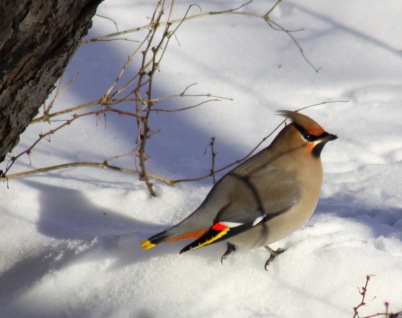
Cedar Waxwing in the snow (Fair Use/Public Domain: photo by anonymous retiree)
In fact, waxwings are resilient, able to tough out winter weather when they must.
Some birds attempt to overwinter in northern regions so long as it is [relatively] mild and they can find food. When the cold, the frost and the snow step in with full force, however, they have no alternative but to leave on winter migration. This can be observed at Falsterbo [in Skåne, Sweden], for example, during periods of severe winter weather: crows, finches, larks, starlings, gulls, ducks and geese leave southern Sweden and head out over the sea in a southwesterly direction towards milder regions.
Sometimes the [migratory] passage goes on in blizzard conditions, as for example on the December morning with whirling snow, less than 50 m visibility and wind strengths of over 15 m/s [i.e., > 30 mph] when Gunnar Roos logged emigration at Falsterbo of Fieldfare, Starling, Skylark, [Bohemian] Waxwing and Common Gull.
[Quoting Thomas Alerstam, BIRD MIGRATION (Cambridge University Press, 1993), page 316.]

Cedar Waxwings sharing food (Fair Use credit; Wild for Wildlife photo)
So there you have it: Cedar Waxwings, on the move, migrating huge distances twice a year, alternating between summer and winter ranges. Mealtimes involve a mix of snapping up fruits fallen to the ground, or happily eating (and sometimes sharing) seeds and berries while perching en banc in tree branches, or snatching “fast food” insects on the wing. Lots of air miles for this crested traveler — migrating with its group (and taking group “rest stops” along the way), and casually sharing the “wealth” and enjoying one another’s company, gregariously illustrating the airborne and passerine equivalents of Amos 3:3. ><> JJSJ

Cedar Waxwing with berry (Smithsonian Nat’l Zoo photo)
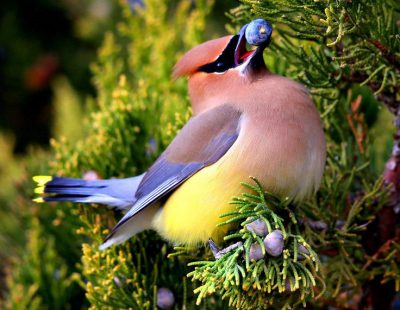

Just an update — it was about March 1st this year (AD2019) when I observed a large group of Cedar Waxwings, eating berries in trees on the north side of my house, as part of their nutrition-packing stopover, before they continued their journey northward, as winter fades into spring. What a privilege it was, to see these waxwings hungrily feasting on the berries, clustered together in the branches of my trees. (Providentially, I was refilling my pool with chlorine tablets, so I was outside at the right place, at the right time, to see these beautiful pass-through migrants.) Notice how this is about a month earlier that the pass-through that I observed in AD2017.
LikeLike
A very interesting and uniquely beautiful bird Lee, thanks for sharing them.
LikeLiked by 2 people
Thanks, but Dr. Johnson wrote this. He always has great and interesting articles.
LikeLiked by 2 people
Thanks for the kind words, Lee. Of course, you routinely rescue my errors by salvaging edits, providing polish to the photograph formatting and/or by adding extra pictures.
LikeLiked by 1 person
Pingback: Passarinho encantador. – escreversonhar